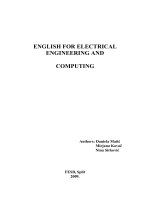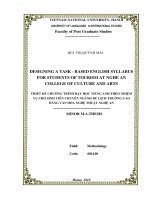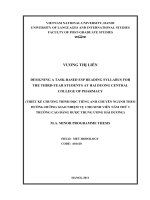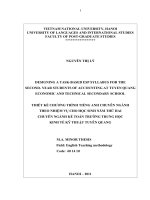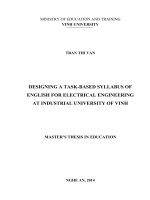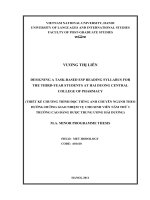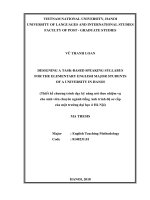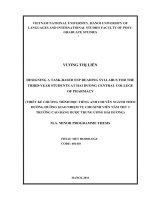Designing a task based syllabus of english for electrical engineering at industrial university of vinh
Bạn đang xem bản rút gọn của tài liệu. Xem và tải ngay bản đầy đủ của tài liệu tại đây (1.09 MB, 110 trang )
MINISTRY OF EDUCATION AND TRAINING
VINH UNIVERSITY
TRAN THI VAN
DESIGNING A TASK-BASED SYLLABUS OF
ENGLISH FOR ELECTRICAL ENGINEERING
AT INDUSTRIAL UNIVERSITY OF VINH
MASTER’S THESIS IN EDUCATION
NGHE AN, 2014
MINISTRY OF EDUCATION AND TRAINING
VINH UNIVERSITY
TRAN THI VAN
DESIGNING A TASK-BASED SYLLABUS OF
ENGLISH FOR ELECTRICAL ENGINEERING
AT INDUSTRIAL UNIVERSITY OF VINH
Major: Teaching English to Speakers of Other Languages (TESOL)
Code: 60140111
MASTER’S THESIS IN EDUCATION
Supervisor: Tran Ba Tien, Ph.D.
Nghe An, 2014
STATEMENT OF AUTHORSHIP
I hereby acknowledge that this study is mine. The data and findings
discussed in the thesis are true, used with permission from associates, and have not
been published elsewhere.
Author
Tran Thi Van
i
ACKNOWLEDGEMENTS
First of all, I would like to express my deep gratitude to Dr. Tran Ba Tien,
who directly instructed and helped me carry out the study. His detailed feedback
and insight, his kindness and enthusiasm have encouraged me over the time of
conducting the study.
Next, I would like to show my special thankfulness to Ms. Nguyen Thi Hue
(Teacher of English at Industrial University of Vinh) who provided valuable
comments in the building the foundations for the current study.
Then, I would really thank my classmates Ms. Nguyen Thi Kieu Van and Ms.
Nguyen Thi Anh Hong for their friendliness, generous assistance which contributed
significantly to the result of the study
Moreover, I am also grateful to the electric technicians, engineers working
in some companies in Nghe An and some teachers who helped me to answer the
questionnaire as well as interview questions enthusiastically.
Last but not least, I would like to devote my special thanks to my dear family,
my dear husband, my dear children for their love and encouragement during the
process of the study.
ii
TABLE OF CONTENT
STATEMENT OF AUTHORSHIP i
ACKNOWLEDGEMENTS ii
Last but not least, I would like to devote my special thanks to my dear family, my
dear husband, my dear children for their love and encouragement during the process
of the study. ii
TABLE OF CONTENT iii
ABSTRACT vi
LIST OF ABBREVIATIONS vii
LIST OF TABLES viii
LIST OF FIGURES ix
Chapter 1 INTRODUCTION 1
1.1. Rationale 1
1.2. The aims and objectives of the study 2
1.3. Research questions 2
1.4. Scope of the study 3
1.5. Design of the study: 3
Chapter 2 LITERATURE REVIEW AND THEORETICAL BACKGROUND 4
2.1. Previous studies related to the research. 4
2.2. English for specific purposes (ESP) 5
2.2.1. Definition of ESP 5
2.2.2. What is electrical engineering? 6
2.2.3. What is English for electrical engineering? 6
2.3. Syllabus 6
2.3.1. Definitions of syllabus 6
2.3.2. Types of syllabus 7
2.4. Task –based syllabus 8
iii
2.4.1. What is task-based syllabus? 8
2.4.2. The advantages of Task-based language learning 11
2.5. Approaches to syllabus design 12
2.5.1. Language - centered approach 12
2.5.2. Skills- centered approach 13
2.5.3. Learning- centered approach 13
2.6. Principles of Syllabus design 14
2.6.1. Situational analysis. 14
2.6.2. Needs Analysis 16
2.6.3. Goals and objectives of the ESP course 22
Chapter 3 NEEDS ANALYSIS AND METHODOLOGY 25
3. 1. Situational analysis. 25
3.1. 1. Institutional factors 25
3. 1.2. Teacher factors 26
3.1.3. Learner factors 26
3.1.4. English Courses at IUV 27
3.2. The Study 28
3.2.1. Research approach 28
3.2.2. Participants 29
3.2. 3. Instruments for data collection 29
3.3. Data analysis 31
3.4. Procedure 31
Chapter 4 FINDINGS ANG DISCUSSION 32
4.1. The findings 32
4.1.1. Needs on designing a task-based syllabus perceived by the respondents 32
4.1.2. The expectation of the task-based syllabus in terms of objectives 35
iv
4.1.3. The overview of the use of English in electrical field. 38
4.1.4. The view on tasks needed to be included in the syllabus. 42
4.1.5. Topic selections needed to be included in the syllabus. 44
4.1.6. The elements needed to be in the syllabus 48
4.1.7. The teachers’ view on Grammar and structures needed to be included in the
syllabus 51
4.2. Suggested ESP Syllabus for Electric Learners at IUV 53
4.2.1. Objective and subjective needs. 53
4.2.2. Problematizing and situation 55
4.2.3. Goals and objectives 56
4.2.4. Outline for Course Content (Specifications/Course Content) 57
4.2.5. Evaluation 61
Chapter 5 CONCLUSION AND IMPLICATION 64
5.1. Conclusion 64
5.3. Implications 65
5.4. Limitations 66
5.5. Suggested for further research 67
REFERENCE 68
APPENDIX 1 72
v
ABSTRACT
This study attempted to design a task-based syllabus for Electrical
Engineering at Industrial University of Vinh. The aims of the study are to explore
students’needs in learning ESP of electrical students at IUV, to select appropriate
topics and tasks in an ESP syllabus; and find out some elements for a suggested
syllabus that meet the learners’ needs and purposes of learning ESP. Finally, based
on the finding, the suggested syllabus and two ESP sample lessons were designed.
The subjects for this study consist of 100 electrical students, 20 ex-students
and 20 teachers of English. The data were mainly collected through questionnaires
and interviews. The data collected were analyzed according to statistical frequency
and percentage.
The research findings indicated that the students’ needs in the ESP course,
such as purposes of learning, expectation of the course, language skill, preferences
of topics and so on were pointed out. In addition, the results from the study also
revealed the tasks; sources of materials and common topics needed to teach in the
ESP course and language functions and language forms are included in the syllabus.
vi
LIST OF ABBREVIATIONS
1. ESP : English for Specific Purposes
2. GE : General English
3. IUV : Industrial University of Vinh
4. IUH : Industrial University of Ho Chi Minh City
5. LSA : Learning situation analysis
6. TBL : Task-based learning
7. SLA : Second-language acquisition
8. TSA : Target situation analysis
vii
LIST OF TABLES
Table 4.2. Students’ view on frequency tasks needed in the syllabus 42
viii
LIST OF FIGURES
ix
Chapter 1
INTRODUCTION
1.1. Rationale
English has been the most popular international language for ages. Specially,
in the new era of high technology and communication, English is playing a more
and more important role and having a strong impact on many fields of the society.
Moreover, the economic open-door policy pursued by the government of Vietnam
has increased a demand for studying English. Every day an increasing number of
people learn and use English for different purposes.
Due to the demand of scientific technological development, economic
integration into the world, English has been very necessary for students studying in
various departments at universities. Furthermore, the boom of foreign investment in
industrial field has created more and more opportunities for students, especially
technical students, to work in foreign companies after graduating. Graduated
students must be equipped with work skills and basic knowledge of English for
Specific Purposes (ESP) so that they can use English in their job effectively.
Industrial University of Vinh (IUV) was established in 2009, It was first a branch
of Industrial University of Ho Chi Minh City (IUH), a repute university with 6 branches
in the country. And the university is now separated in to an independent university. So
together with the growing demand for learning English, English is a compulsory subject
for all courses including General English (GE) and English for specific purpose (ESP).
With more than 6 years of experiences in teaching English for Electrical
Engineering at IUV, I found that students have coped with significantly difficulties
in studying ESP because of following reasons. Firstly, their English level is low and
many of them lack skills which they weren’t taught at high school. So it is very hard
for them to study ESP. Secondly, there is a problem of syllabus design at IUV.
There have not been ESP syllabuses in general and ESP syllabus for Electrical
Engineering in particular. The university chooses the textbook “English for
Electrical Engineering, Dang Quoc Tan (2006)” to use as the only text book for
1
ESP course. This kind of material seems to be difficult for the students because there are
too many technological words and grammar structures. Besides, some topics are not
suitable for students’ level and not relevant to students’ needs in their future jobs.
All these reasons make me always think about how to get an appropriate
syllabus for electrical students which can help them practice English in their future
job and they can meet the requirements of the society after they graduate. So I think
that the shortage of an appropriate syllabus for electrical students at the IUV is a big
and urgent question waiting to be answered. And it is of great necessity and
significance to both teachers who are teaching ESP and electrical students. That is
the reason why I have decided to carry out the study entitled: “Designing a task - based
syllabus of English for Electrical Engineering at Industrial University of Vinh”.
Hopefully, my devotion and efforts will make a contribution to the English teaching and
learning of the teachers and students at IUV.
1.2. The aims and objectives of the study
The aim of the study is to design an appropriate task - based syllabus of
English for Electrical Engineering at Industrial University of Vinh.
To achieve this aim, three objectives are set to be obtained:
- To investigate and analyze students’needs in learning ESP of electrical
students at IUV.
- To find out the real tasks which the electrical students need in order to
decide a task- based syllabus to motivate students in learning ESP at IUV.
- To provide some sample units and some suggestions in teaching English for
Electrical Engineering to improve the quality of ESP teaching and learning at IUV.
1.3. Research questions
The study tries to answer the following questions:
1. What are the needs of learning ESP to electrical students at Industrial
University of Vinh?
2. What should be included in a task- based ESP syllabus for electrical
students to meet their needs?
2
1.4. Scope of the study
This study focuses on exploring the needs of electrical students in learning ESP
and then designing an appropriate ESP task- based syllabus for electrical students at
IUV. Due to the limitation of time, the author only fulfilled the study among twenty
teachers of English, twenty graduated Electrical students and one hundred Electrical
students at IUV.
1.5. Design of the study:
This research comprises five chapters
Chapter 1: Introduction – this chapter provides the rationale of the problem
tackling with the topic, the background and the aim of the study, the scope and the
research questions
Chapter 2: Literature review and theory background- this chapter
provides a review of the previous studies related to the thesis and provides some
theoretical concepts for the study.
Chapter 3: Analysis needs and methodology - This chapter introduces the
needs analysis, research methodology, subject of the study, instrumentation,
procedures for conducting the study, data collection and data analysis.
Chapter 4: Findings and discussions - This chapter presents the results and
discussions developed after the needs are analyzed.
Chapter 5: Conclusion and implications - This chapter presents some
discussion, the conclusions, the implications and the limitations of the study.
3
Chapter 2
LITERATURE REVIEW AND THEORETICAL BACKGROUND
This chapter focuses on the literature review and theoretical background of
the study. It includes a number of important theoretical terms related to ESP
syllabus, needs analysis, principles for syllabus design and previous studies related
to the research will also be mentioned.
2.1. Previous studies related to the research.
ESP syllabus design is a popular term that has attracted many researchers
recently. Helen Basturkmen (2010) studied in ESP course development for the
Police and for Medical Doctors. In English for Thesis Writing, Cooley and
Lewkowicz (1995, 1997) showed supervisors reported students had difficulties with
surface-level grammar. Hutchingson and Water (1986) considered the matching
learners need to aims in ESP course design. Chen (2006) considered the process of
designing ESP program for learners of various institutions.
In Vietnam, just like the other developing countries, the demand for ESP
courses rapidly increased. So far, there have been great deals of studies related to
the ESP designing syllabus and teaching ESP at colleges. Chi (2008) explored the
Learners’ needs of ESP electronic students at Hue University. Phuong (2010)
designed a syllabus for an extensive speaking course for reception staff in Hue.
Chung (2011) designed an ESP speaking syllabus for the second year students of
business administration at Industrial University of Ho Chi Minh City, Nghe An
branch. Le (2010) designed sample units of English for Mechanical Engineering for
students at Hue College of Agriculture and forestry. Thanh (2008) explored the
impact of task-based learning on motivating non- English majors to acquire
vocabulary in Can Tho University.
4
2.2. English for specific purposes (ESP)
2.2.1. Definition of ESP
ESP has been defined by different researchers. Dudley-Evans gave an extended
definition of ESP in terms of 'absolute' and 'variable' characteristics as below.
Absolute characteristics
• ESP is defined to meet specific needs of the learners
• ESP makes use of underlying methodology and activities of the discipline
it serves
• ESP is centered on the language appropriate to these activities in terms of
grammar, lexis, register, study skills, discourse and genre.
Variable characteristic
• ESP may be related to or designed for specific disciplines
• ESP may use, in specific teaching situations, a different methodology from
that of general English
• ESP is likely to be designed for adult learners, either at a tertiary level
institution or in a professional work situation. It could, however, be for learners at
secondary school level
• ESP is generally designed for intermediate or advanced students
• Most ESP courses assume some basic knowledge of the language systems
Dudley – Evans and St John (1998, p. 5)
It is possible to see that ESP is not necessarily related to a specific discipline.
Furthermore, ESP courses are based on learners’ needs. Sharing the same opinion,
Hutchinson and Waters (1986, p. 9) define that "ESP is an approach to language
teaching in which all decisions as to content and method are based on the learner's
reason for learning".
From the ESP definitions, the main ESP characteristics are focus on learners’
needs. Thus the aim of ESP teaching is to help students use English effectively that they
will meet in real situations in their future professions or need for their further education.
Hutchinson and Waters regard ESP as “an approach to language teaching in
which all decisions as to content and method are based on the learners’ reason for
5
learning” (Hutchinson and Waters, 1987, p.17). ESP must be seen as an approach
not as a product and is directed by specific and apparent reasons for learning ESP.
Students' goal of 1earning a second 1anguage might acquire not only general
linguistics competencies but also academic and job-related skills.
2.2.2. What is electrical engineering?
Electrical engineering is a field of engineering that generally deals with the
study and application of electricity, electronics and electromagnetism (Wikipedia).
It now covers a range of subtopics including power, electronics, control systems,
signal processing and telecommunication.
2.2.3. What is English for electrical engineering?
English for electrical engineering is an application of ESP according to
learners’ language needs for their study and work during and after graduation.
English for electrical engineering is a branch of English for Specific Purposes - an
approach to language learning, which is based on the learner’s need (Hutchinson
and Waters, 1987, p. 19).
The needs of learners of English for electrical engineering are to use English
for their communication in real life and their professional knowledge development.
It means that learning English for electrical engineering aims to listen, speak, read,
and write documents relating to electric power in English. Therefore, English for
electrical engineering has become a language tool, which helps the workers,
engineers, electrical experts, managers, and electrical students to obtain, access and
exchange information with other people in English.
2.3. Syllabus
2.3.1. Definitions of syllabus
There are different opinions about syllabus definitions
Hutchinson and Waters (1987: 80) defined syllabus as follow: “At its simplest
level a syllabus can be described as a statement of what is to be learnt. It reflects
language and linguistic performance. This is rather traditional interpretation of syllabus
focusing on outcomes than process.”
6
According to Widdowson (1983, p. 26) “a syllabus is simply a framework
within which activities can be carried out: a teaching device to facilitate learning.
It only becomes a threat to pedagogy when it is regarded as absolute rules for
determining what is to be learnt rather than points of reference from which bearing
can be taken”.
And Yalden (1983, p. 14) defined syllabus that “ The syllabus is now seen as
an instrument by which the teachers, with the help of the syllabus designers, can
achieve a degree of “fit” between the needs and aims of the learners(as social
being and as individual) and the activities which will take place in the classroom”
And there are several conflict views on just what is that distinguishes
syllabus design from curriculum development. There is also some disagreement
about the nature of syllabus: “Curriculum is a very general concept which involves
consideration of the whole complex of philosophical, social and administrative
factors which contribute the planning of an educational program. Syllabus, on the
other hand, refers to that subpart of curriculum which is concerned with a
specification of what units will be taught (as distinct from how they will be taught,
which is a matter for methodology)” (Allen, 1983, p. 61)
In short, syllabus is considered as a framework for both teachers and learners
to follow to gain the specific goals.
2.3.2. Types of syllabus
According to Hutchinson and Waters (1987), Richards (1990) and Nunan
(1991) types of syllabuses can be listed as follows:
Structural syllabus: the content of language teaching is a collection of the
form and the structures; usually grammatical; of the language being taught.
Functional/notional syllabus: the content of teaching is a collection of the
functions that are performed when language is used to express.
Situational syllabus: the content of teaching is a collection of real or
imaginary situations in which language occurs or is used. It presents a set of
everyday situations or settings. The primary purpose of a situational language
teaching syllabus is to teach the language that occurs in the situations.
7
Skill - based syllabus: the content of teaching is a collection of specific
abilities that may play a part in using language. Skills are things that people must be
able to do to be competent in a language, relatively independently of the situation or
setting in which the language use can occur. The primary purpose of skill-based
instruction is to learn the specific language skill.
Content- based syllabus: focuses on subjects in a school curriculum such as
science or social studies. The primary purpose of instruction is to teach some
contents or information using the language that the students are also learning.
Task-based syllabus: The content of the language teaching is a series of
complex and purposeful task that the students want or need to perform with the
language they are learning. The tasks are defined as activities with a purpose other
than language learning.
Theme/ topic – based syllabus: uses topics or themes as its starting points
such as health, food, clothing.
2.4. Task –based syllabus
2.4.1. What is task-based syllabus?
In Longman Dictionary of Language Teaching & Applied Linguistics, task-
based syllabus, along with procedural syllabus, is defined as follows:
“…a SYLLABUS which is organized around TASK, rather than in terms of
grammar or vocabulary. For example the syllabus may suggest a variety of
different kinds of tasks which the learners are expected to obtain information;
drawing maps based on oral instructions; performing actions based on commands
given in the target language; giving orders and instructions to others, etc. It has
been argued that this is a more effective way of learning a language since it
provides a purpose for the use and learning of a language other than simply
learning language items for their own sake.”
(Longman Dictionary of Language Teaching & Applied Linguistics (2001, p.469)
Richards (2001, p. 20) notes that the task- based syllabus is organized around
different tasks and activities that the learners would carry out in target language. He
indicates the definition of a task which is an activity or goal that is carried out using
8
language such as finding a solution to a puzzle, reading a map and giving direction,
or reading a set of instructions and assembling a toy. Added to that, Skehan (1996)
states: “tasks are activities which have meaning as their primary focus. Success in
tasks is evaluated in terms of achievement of an outcome, and tasks generally bear
some resemblance to real – life language use.”
The main organizing principle of task-based syllabuses is activities or tasks.
The procedural or task-based syllabuses consist of a set of tasks or activities ordered
according to cognitive difficulty. According to Robinson (1991, p. 39), “class time
is devoted to performance of the tasks and attention is only consciously directed to
language if this is necessary for completion of the task”. A major concern is that
students understand the task and what they are doing, and do not act in a mechanical
way.
Richards (2001) holds that all teaching makes use of tasks of different kinds.
A task based syllabus, however, is one based on tasks that have been specially
designed to facilitate second language learning and on which tasks or activities are
the basic unit of the syllabus. While carrying out the tasks, learners are said to
receive comprehensible input and modified output, processes believed central to
second language acquisition.
Long and Crookes (1992, p. 43) assert that tasks “provide a vehicle for the
presentation of appropriate target language samples to learner – input which they
will inevitably reshape via application of general cognitive processing capacities
and for the delivery of comprehension and production opportunities of negotiable
difficulty.”
Jack C. Richards (2001) clarifies the basic claims for a task – based syllabus is:
• Tasks are activities that drive the second language acquisition process.
• Grammar teaching is not central with this approach because learners will
acquire grammar as a by – product of carrying out tasks.
• Tasks are motivating for learners and engage them in meaningful
communication.
9
Two kinds of tasks have been proposed as a basis for syllabus design:
pedagogical tasks and real – world tasks. Pedagogical tasks are based on SLA
theory and are designed to trigger second language learning processes and
strategies. The following are tasks of this kind.
• Jigsaw tasks: these tasks involve learners in combining different pieces of
information to form a whole.
• Information – gap tasks: tasks in which one student or group of students
has one set of information and another student or group has a complementary set of
information. They must negotiate and find out what the other party’s information is
in order to complete an activity.
• Problem solving tasks: students are given a problem and set of
information. They must arrive at a solution to the problem. There is generally a
single resolution of the outcome.
• Decision – making tasks: students are given a problem for which there are
a number of possible outcomes and they must choose one through negotiation and
discussion.
• Opinion exchange tasks: learners engage in discussion and exchange of
ideas. They do not need to reach agreement.
• Nevertheless, at present, task – based syllabuses have not been widely
implemented in language teaching. They relate to the common issues:
• Definition of task: definitions of tasks are sometimes so broad as to
include almost anything that involves learners doing something.
• Design and selection of tasks: procedures for the design and selection of
tasks remain unclear.
• Development of accuracy: excessive use of communicative tasks may
encourage fluency at the expense of accuracy.
Nunan (1988) ascertains the main difficulty of this type of syllabus lies in the
degree of contextual support, the cognitive difficulty of the task, the amount of
assistance, the language complexity, the psychological stress, and the amount and
type of knowledge background.
10
As Robinson (1991, p. 40) concludes task-based syllabuses are of clear
significance for ESP students those have the need of employing English for the
purposes of occupation and education, “using the medium of English, they should
successfully perform a work or study task”.
A model for task-based learning was outlined by Willis J. (1996) and refers to
three stages: the pre-task, the task cycle, and language focus.
In the pre-task stage, the topic is defined and essential vocabulary is highlighted
by the teacher. In the task cycle, learners perform the task in pairs or small groups,
rehearse their reports before presenting findings in front of the audience. During the
task, the teacher monitors and encourages all attempts at communication without
correcting. Willis suggests that this harbors a free environment in which learners are
willing to experiment (as mistakes aren't important).During the planning stage, the
learners are aware that their output will be 'made public' and will consequently aim
for accuracy. The role of the teacher here is therefore to provide assistance with
regard to language advice. The teacher then chairs the report, and comments on the
content. At this stage, the focus is on both fluency and accuracy. In addition, the
learners may hear a recording or read a text of a similar task, in order to compare
how they did it.
Language focus is the final stage, during which specific language features that
learners encountered in the task are examined and analyzed. Some practice of
language features and feedback on students’ performance are appropriate in this
stage. The learners are given the opportunity to reflect on how they performed the
task and on the new language they used in this final part of the lesson.
2.4.2. The advantages of Task-based language learning
Theoretically using task-based approach in ESP lessons provides the learners
with an opportunity to use the language they need for genuine communication. This
approach benefits not only the learners, but also the ESP teachers in designing
materials.
Willis (2007) presents the main advantages of TBL
- There is no language control in production stage.
11
- Learners use their language knowledge and resources
- Learners experiment with language during task completion
- Learners’ communicate and collaborate during activities
- Target language emerges from students’ needs
- TBL offers reflection on language use.
According to Adam and Firth (1979), the task-based approach provides both
short-term motivation and long-term motivation for learners. At ESP lessons,
achieving the professional and language knowledge in combination with doing
some tasks may raise the short-term motivation at a classroom. Long-term
motivation will be gained from successfully completing tasks after having passed an
exams or obtained good test results. Task-based learning provides a clear and
purposeful context for the learning of grammar and other linguistic features. Such a
language focus in context may actually speed up the acquisition process and enable
learners to systematize their knowledge of the target language structures and
functions. The role of task-based learning is to stimulate desire in learners to
improve their language proficiency by challenging them to complete meaningful
and authentic tasks.
With task-based learning approach teacher find easy to receive feedback
from learners. The process of doing various tasks reflects how students learn a
language and how much progress they can achieve or what mistakes they often
make in practicing the communicative skills.
2.5. Approaches to syllabus design
Approaches to syllabus design are an important factor that must be taken into
account when designing a language course. According to Hutchinson and Waters
(1987), approaches to syllabus design are divided into three main kinds, namely:
language centered, skill – centered and learning – centered.
2.5.1. Language - centered approach
The language-centered approach “aims to draw as a direct connect as
possible between the analysis of the target situation and the content of the ESP
12
course” (Hutchinson and Waters, 1987, p. 65).
Although this approach seems to be logical and straightforward, it also
reveals its weaknesses. Firstly, it starts from the learners and their needs, but is not a
learner-centered approach. The learner is used to identify the target situation but
their learning needs are not accounted for at all. Only a restricted area of language is
taught. Secondly, it can also be criticized for being a static and inflexible procedure,
taking little account of the conflicts and contradictions that are inherent in any
human endeavor. Moreover, it the language-centered analysis of target situation
data is only at the surface level, revealing very little about the competence that
underlines the performance.
2.5.2. Skills- centered approach
The basic theoretical hypothesis of this approach is that: “underlying any
language behavior are certain skills and strategies, which the learner use in order to
produce or comprehend discourse” (Hutchinson and Waters, 1987, p. 69). Hence,
this approach focuses on developing learners’ skills and strategies.
This approach shows more advantages than gives no acknowledgement to
factors which must play a part in the creation of any course. Lastly, the language-
centered one in that it can take the learner more into account than the former; it
aims to get away from the surface performance data and look at the competence that
underlies the performance. However, despite its concern for the learner, the skills –
centered approach still regards the learner as a user of language rather than as a
learner of language and it is concerned with the process of language use, not of
language learning.
2.5.3. Learning- centered approach
Richards (2001, p.117) assumes that “in a learner – centered approach when
a syllabus is designed, the learners should be seen as the point of reference for
making decision relating to both the teaching content and teaching form.” Learner
centeredness stresses the individual needs of learners, the role of individual
experience and the need to develop awareness, self – reflection, critical thinking,
13
learner strategies, and other qualities and skills that are believed to be important for
learners to develop.
Nunan (1991, p.22) claims that the key difference between learner –
centered and traditional approach is that in the former, the curriculum or syllabus in
particular “is a collaborative effort between teachers and learners, since learners are
closely involved in the decision making process regarding the content of the
syllabus and how it is taught”.
According to Hutchinson and Waters (1987), a learner – centered approach
is based on the principle that learning is totally determined by the learners. They
prefer the term learning centered approach to the term learner centered approach
to indicate that the concern is to maximize learning. Learning is seen as, in which
the learners use what knowledge or skills they have in order to make sense of the
flow of new information. Therefore, learning is an internal process which is
crucially dependent on the knowledge the learners already have and their ability and
motivation to use it.
In order to design and ESP syllabus for Electrical Engineering at IUV, an
integrated approach will be the choice, the rationale for this to maximize the
advantages and minimize the drawbacks of each approach.
2.6. Principles of Syllabus design
2.6.1. Situational analysis.
According to Jack C. Richards (2001), Situation analysis is an analysis
factors in the context of a planned or present curriculum project that is made order
to assess their potential impact on the project. Situation analysis complement the
information gathered during need analysis. It is sometimes considered as a
dimension of needs analysis, and can also be regarded as an aspect of evolution.
2.6.1.1. Education setting
Richards (2011) indicated that Educational setting is a very important in
situation analysis. And Morris (1994, p. 104) also pointed that: “Schools are
organization and they develop a culture, ethos, or environment which might be
14

